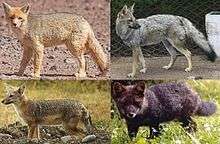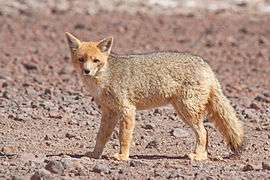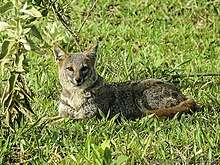South American fox
The South American foxes (Lycalopex), commonly called raposa in Portuguese, or zorro in Spanish, are a genus of the family Canidae from South America. Despite their name, they are not true foxes, but are a unique canid genus related to wolves and jackals; some of them somewhat resemble foxes due to convergent evolution. The South American gray fox, Lycalopex griseus, is the most common species, and is known for its large ears and a highly marketable, russet-fringed pelt.
| Lycalopex[1] | |
|---|---|
 | |
| Scientific classification | |
| Kingdom: | Animalia |
| Phylum: | Chordata |
| Class: | Mammalia |
| Order: | Carnivora |
| Family: | Canidae |
| Subfamily: | Caninae |
| Tribe: | Canini |
| Genus: | Lycalopex Burmeister 1854 |
| Species | |
| |
| Synonyms | |
| |
The second-oldest known fossils belonging to the genus were discovered in Chile, and date from 2.0 to 2.5 million years ago, in the mid- to late Pliocene.[3] The Vorohué Formation of Argentina has provided older fossils, dating to the Uquian to Ensenadan (Late Pliocene).[4]
Names
The common English word "zorro" is a loan word from Spanish, with the word originally meaning "fox". Current usage lists Pseudalopex (literally: "false fox") as synonymous with Lycalopex ("wolf fox"), with the latter taking precedence.[1] The IUCN, for instance, retains the use of Pseudalopex while also acknowledging Lycalopex as a legitimate alternative.[5] In 1895, Allen classified Pseudalopex as a subgenus of Canis, establishing the combination Canis (Pseudalopex), a name still used in the fossil record.[2]
Species
Species currently included in this genus include:[1]
| Image | Name | Common name | Distribution |
|---|---|---|---|
 | Lycalopex culpaeus | Culpeo or Andean fox | Ecuador and Peru to the southern regions of Patagonia and Tierra del Fuego |
 | Lycalopex fulvipes | Darwin's fox | Nahuelbuta National Park (Araucanía Region), the Valdivian Coastal Range (Los Ríos Region) in mainland Chile and Chiloé Island |
| Lycalopex griseus | South American gray fox | Argentina and Chile | |
_4_(cropped).png) | Lycalopex gymnocercus | Pampas fox | northern and central Argentina, Uruguay, eastern Bolivia, Paraguay, and southern Brazil |
 | Lycalopex sechurae | Sechuran fox | Sechura Desert in southwestern Ecuador and northwestern Peru |
 | Lycalopex vetulus | Hoary fox | south-central Brazil |
| †Canis (Pseudalopex) australis | Vorohué Formation, Uquian-Ensenadan Argentina[4] | ||
In 1914, Oldfield Thomas established the genus Dusicyon, in which he included these zorros. They were later reclassified to Lycalopex (via Pseudalopex) by Langguth in 1975.[1]
Phylogeny
The following phylogenetic tree shows the evolutionary relationships between the Lycalopex species, based on molecular analysis of mitochondrial DNA control region sequences.[6]
| Lycalopex |
| ||||||||||||||||||||||||||||||
Relationship with humans
The zorros are hunted in Argentina for their durable, soft pelts. They are also often labelled 'lamb-killers'.
References
- Wozencraft, W.C. (2005). "Order Carnivora". In Wilson, D.E.; Reeder, D.M (eds.). Mammal Species of the World: A Taxonomic and Geographic Reference (3rd ed.). Johns Hopkins University Press. ISBN 978-0-8018-8221-0. OCLC 62265494.
- Canis (Pseudalopex) australis at Fossilworks.org
- Lucherini, M. & Luengos Vidal, E. M. (2008). "Lycalopex gymnocercus (Carnivora: Canidae)". Mammalian Species. 820: Number 820, pp. 1–9. doi:10.1644/820.1.
- Vorohuen (sic; Vorohué) Formation at Fossilworks.org
- Jiménez, J. E. (2008). "Pseudalopex culpaeus". IUCN Red List of Threatened Species. 2008. Retrieved May 8, 2012.
- Tchaicka, Ligia; Freitas, Thales Renato Ochotorena de; Bager, Alex; Vidal, Stela Luengos; Lucherini, Mauro; Iriarte, Agustín; Novaro, Andres; Geffen, Eli; Garcez, Fabricio Silva; Johnson, Warren E.; Wayne, Robert K.; Eizirik, Eduardo (2016). "Molecular assessment of the phylogeny and biogeography of a recently diversified endemic group of South American canids (Mammalia: Carnivora: Canidae)" (PDF). Genetics and Molecular Biology. 39 (3): 442–451. doi:10.1590/1678-4685-GMB-2015-0189. PMC 5004827. PMID 27560989.
| Wikispecies has information related to South American fox |
| Wikimedia Commons has media related to Pseudalopex. |
Further reading
- Nowak, Ronald M. (2005). Walker's Carnivores of the World. Baltimore: Johns Hopkins Press. ISBN 0-8018-8032-7